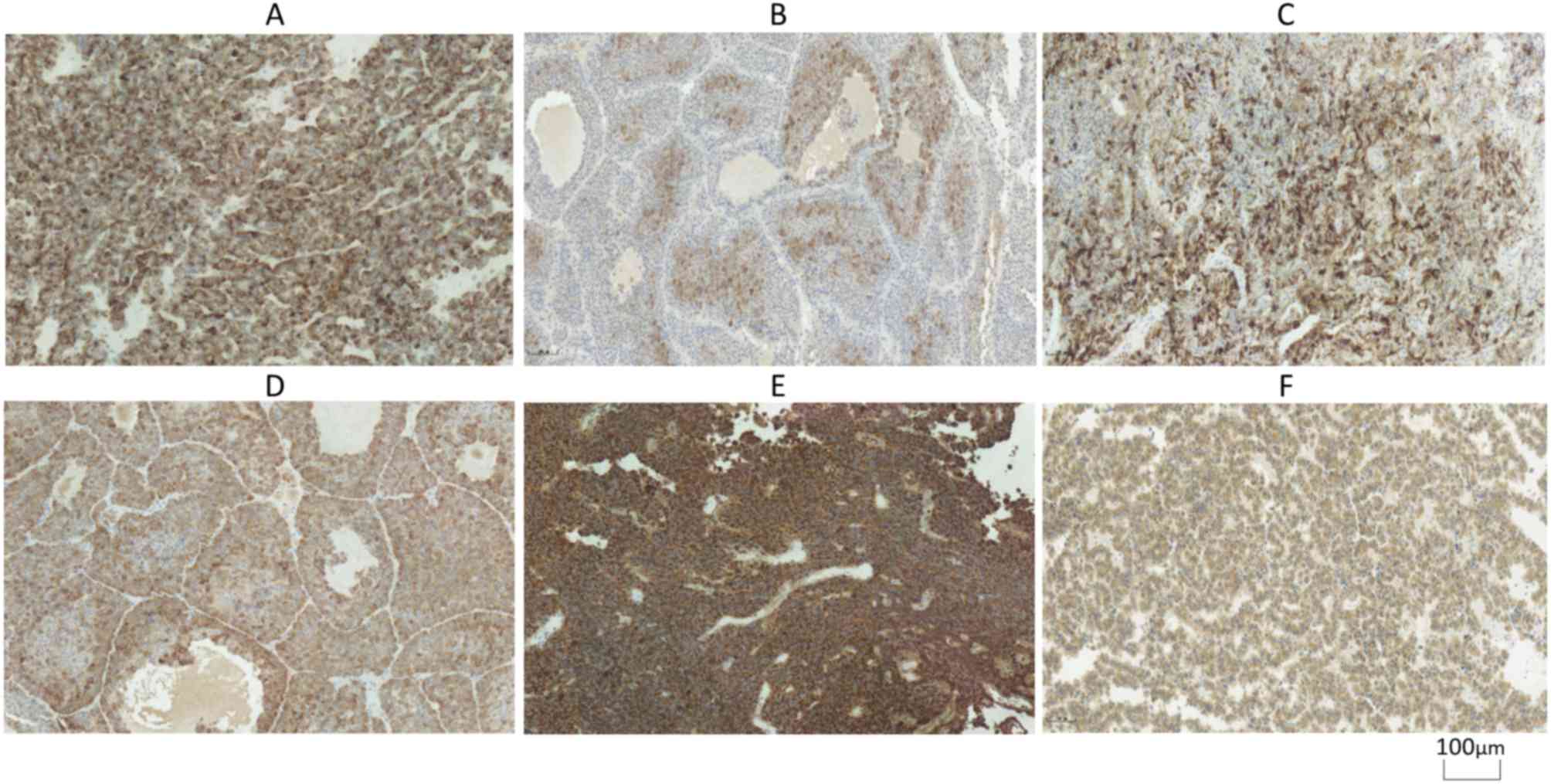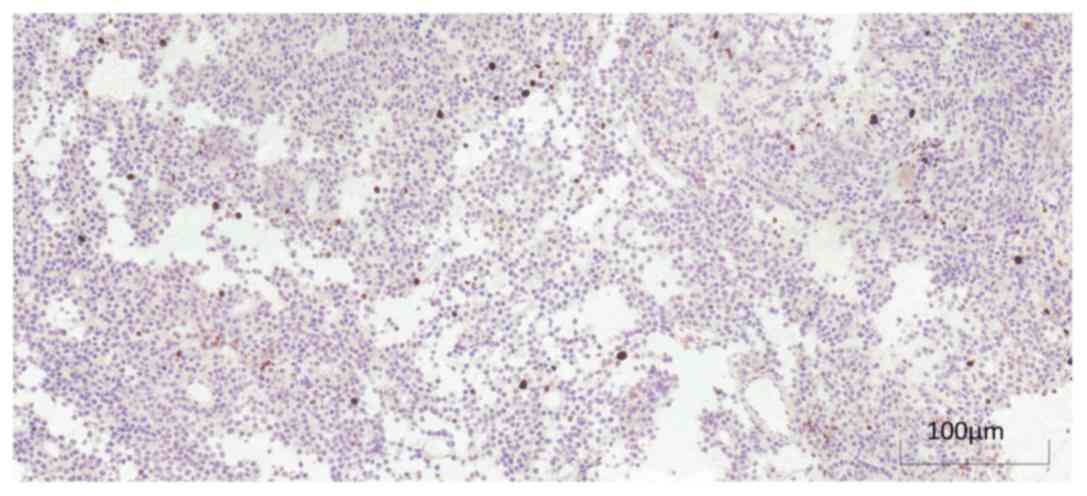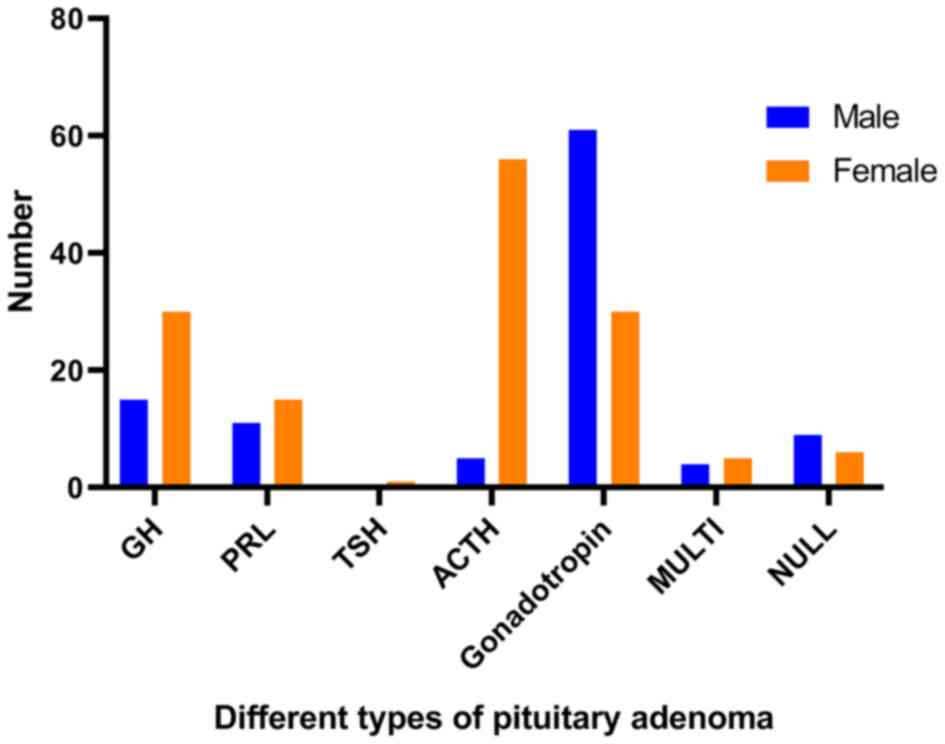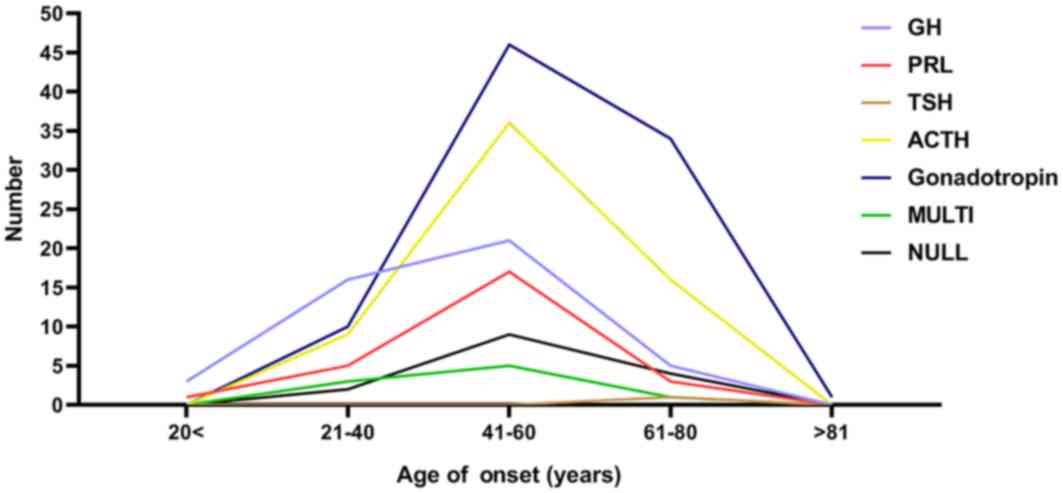|
1
|
Kovacs K: The 2004 WHO classification of
pituitary tumors: Comments. Acta Neuropathol. 111:62–63. 2006.
View Article : Google Scholar : PubMed/NCBI
|
|
2
|
Lopes MBS: The 2017 world health
organization classification of tumors of the pituitary gland: A
summary. Acta Neuropathol. 134:521–535. 2017. View Article : Google Scholar : PubMed/NCBI
|
|
3
|
Asa SL, Bamberger AM, Cao B, Wong M,
Parker KL and Ezzat S: The transcription activator steroidogenic
factor-1 is preferentially expressed in the human pituitary
gonadotroph. J Clin Endocrinol Metab. 81:2165–2170. 1996.
View Article : Google Scholar : PubMed/NCBI
|
|
4
|
Lee SL, Sadovsky Y, Swirnoff AH, Polish
JA, Goda P, Gavrilina G and Milbrandt J: Luteinizing hormone
deficiency and female infertility in mice lacking the transcription
factor NGFI-A (Egr-1). Science. 273:1219–1221. 1996. View Article : Google Scholar : PubMed/NCBI
|
|
5
|
Zhao L, Bakke M, Krimkevich Y, Cushman LJ,
Parlow AF, Camper SA and Parker KL: Steroidogenic factor 1 (SF1) is
essential for pituitary gonadotrope function. Development.
128:147–154. 2001.PubMed/NCBI
|
|
6
|
Lamolet B, Pulichino AM, Lamonerie T,
Gauthier Y, Brue T, Enjalbert A and Drouin J: A pituitary
cell-restricted T box factor, Tpit, activates POMC transcription in
cooperation with Pitx homeoproteins. Cell. 104:849–859. 2001.
View Article : Google Scholar : PubMed/NCBI
|
|
7
|
Scully KM and Rosenfeld MG: Pituitary
development: Regulatory codes in mammalian organogenesis. Science.
295:2231–2235. 2002. View Article : Google Scholar : PubMed/NCBI
|
|
8
|
Vallette-Kasic S, Figarella-Branger D,
Grino M, Pulichino AM, Dufour H, Grisoli F, Enjalbert A, Drouin J
and Brue T: Differential regulation of proopiomelanocortin and
pituitary-restricted transcription factor (TPIT), a new marker of
normal and adenomatous human corticotrophs. J Clin Endocrinol
Metab. 88:3050–3056. 2003. View Article : Google Scholar : PubMed/NCBI
|
|
9
|
Sjöstedt E, Bollerslev J, Mulder J,
Lindskog C, Pontén F and Casar-Borota O: A specific antibody to
detect transcription factor T-Pit: A reliable marker of
corticotroph cell differentiation and a tool to improve the
classification of pituitary neuroendocrine tumours. Acta
Neuropathol. 134:675–677. 2017. View Article : Google Scholar : PubMed/NCBI
|
|
10
|
Luo X, Ikeda Y and Parker KL: A
cell-specific nuclear receptor is essential for adrenal and gonadal
development and sexual differentiation. Cell. 77:481–490. 1994.
View Article : Google Scholar : PubMed/NCBI
|
|
11
|
Dasen JS, O'Connell SM, Flynn SE, Treier
M, Gleiberman AS, Szeto DP, Hooshmand F, Aggarwal AK and Rosenfeld
MG: Reciprocal interactions of Pit1 and GATA2 mediate signaling
gradient-induced determination of pituitary cell types. Cell.
97:587–598. 1999. View Article : Google Scholar : PubMed/NCBI
|
|
12
|
Manojlovic-Gacic E, Engstrom BE and
Casar-Borota O: Histopathological classification of non-functioning
pituitary neuroendocrine tumors. Pituitary. 21:119–129. 2018.
View Article : Google Scholar : PubMed/NCBI
|
|
13
|
Kontogeorgos G, Scheithauer BW, Horvath E,
Kovacs K, Lloyd RV, Smyth HS and Rologis D: Double adenomas of the
pituitary: A clinicopathological study of 11 tumors. Neurosurgery.
31:840–849. 1992. View Article : Google Scholar : PubMed/NCBI
|
|
14
|
Raappana A, Koivukangas J, Ebeling T and
Pirilä T: Incidence of pituitary adenomas in northern Finland in
1992–2007. J Clin Endocrinol Metab. 95:4268–4275. 2010. View Article : Google Scholar : PubMed/NCBI
|
|
15
|
Buurman H and Saeger W: Subclinical
adenomas in postmortem pituitaries: Classification and correlations
to clinical data. Eur J Endocrinol. 154:753–758. 2006. View Article : Google Scholar : PubMed/NCBI
|
|
16
|
Eremkina AK, Dzeranova LK, Pigarova EK,
Mokrysheva NG and Dedov II: Morphofunctional features of
non-functioning pituitary adenomas. Arkh Patol. 81:71–78. 2019.(In
Russian). View Article : Google Scholar : PubMed/NCBI
|
|
17
|
García-Sáenz M, Uribe-Cortés D,
González-Virla B, Mendoza-Zubieta V and Vargas-Ortega G: Silent
pituitary plurihormonal adenoma: Clinical relevance of
immunohistochemical analysis. Rev Med Inst Mex Seguro Soc.
57:48–55. 2019.(In English and Spanish). PubMed/NCBI
|
|
18
|
Pappy AL II, Savinkina A, Bicknese C,
Neill S, Oyesiku NM and Ioachimescu AG: Predictive modeling for
pituitary adenomas: Single center experience in 501 consecutive
patients. Pituitary. 22:520–531. 2019. View Article : Google Scholar : PubMed/NCBI
|
|
19
|
Liu J, Zhang X, Yan X, Sun M, Fan Y and
Huang Y: Significance of TERT and ATRX mutations in glioma. Oncol
Lett. 17:95–102. 2019.PubMed/NCBI
|
|
20
|
Micko AS, Wohrer A, Wolfsberger S and
Knosp E: Invasion of the cavernous sinus space in pituitary
adenomas: Endoscopic verification and its correlation with an
MRI-based classification. J Neurosurg. 122:803–811. 2015.
View Article : Google Scholar : PubMed/NCBI
|
|
21
|
Andujar-Plata P, Villar-Taibo R,
Ballesteros-Pomar MD, Vidal-Casariego A, Pérez-Corral B,
Cabezas-Agrícola JM, Álvarez-Vázquez P, Serramito R and Bernabeu I:
Long-term outcome of multimodal therapy for giant prolactinomas.
Endocrine. 55:231–238. 2017. View Article : Google Scholar : PubMed/NCBI
|
|
22
|
Chatzellis E, Alexandraki KI, Androulakis
II and Kaltsas G: Aggressive pituitary tumors. Neuroendocrinology.
101:87–104. 2015. View Article : Google Scholar : PubMed/NCBI
|
|
23
|
Mou C, Han T, Zhao H, Wang S and Qu Y:
Clinical features and immunohistochemical changes of pituitary
apoplexy. J Clin Neurosci. 16:64–68. 2009. View Article : Google Scholar : PubMed/NCBI
|
|
24
|
Tapar K, Kovach K and Khorvat E:
Classification, pathology and molecular biology of pituitary
adenoma. Arkh Patol. 59:7–17. 1997.(In Russian). PubMed/NCBI
|
|
25
|
Klimstra DS: Pathology reporting of
neuroendocrine tumors: Essential elements for accurate diagnosis,
classification, and staging. Semin Oncol. 40:23–36. 2013.
View Article : Google Scholar : PubMed/NCBI
|
|
26
|
Inoshita N and Nishioka H: The 2017 WHO
classification of pituitary adenoma: Overview and comments. Brain
Tumor Pathol. 35:51–56. 2018. View Article : Google Scholar : PubMed/NCBI
|
|
27
|
Cooper O and Melmed S: Subclinical
hyperfunctioning pituitary adenomas: The silent tumors. Best Pract
Res Clin Endocrinol Metab. 26:447–460. 2012. View Article : Google Scholar : PubMed/NCBI
|
|
28
|
Chalkley MD, Kiupel M and Draper AC:
Pituitary null cell adenoma in a domestic llama (Lama glama). J
Comp Pathol. 151:51–56. 2014. View Article : Google Scholar : PubMed/NCBI
|
|
29
|
Raverot G, Burman P, McCormack A, Heaney
A, Petersenn S, Popovic V, Trouillas J and Dekkers OM; European
Society of Endocrinology, : European society of endocrinology
clinical practice guidelines for the management of aggressive
pituitary tumours and carcinomas. Eur J Endocrinol. 178:G1–G24.
2018. View Article : Google Scholar : PubMed/NCBI
|
|
30
|
Colao A, Petersenn S, Newell-Price J,
Findling JW, Gu F, Maldonado M, Schoenherr U, Mills D, Salgado LR
and Biller BM; Pasireotide B2305 Study Group, : A 12-month phase 3
study of pasireotide in Cushing's disease. N Engl J Med.
366:914–924. 2012. View Article : Google Scholar : PubMed/NCBI
|
|
31
|
Yamada S, Fukuhara N, Horiguchi K,
Yamaguchi-Okada M, Nishioka H, Takeshita A, Takeuchi Y, Ito J and
Inoshita N: Clinicopathological characteristics and therapeutic
outcomes in thyrotropin-secreting pituitary adenomas: A
single-center study of 90 cases. J Neurosurg. 121:1462–1473. 2014.
View Article : Google Scholar : PubMed/NCBI
|
|
32
|
Mortini P, Losa M, Barzaghi R, Boari N and
Giovanelli M: Results of transsphenoidal surgery in a large series
of patients with pituitary adenoma. Neurosurgery. 56:1222–1233.
2005. View Article : Google Scholar : PubMed/NCBI
|
|
33
|
Nishioka H, Inoshita N, Mete O, Asa SL,
Hayashi K, Takeshita A, Fukuhara N, Yamaguchi-Okada M, Takeuchi Y
and Yamada S: The complementary role of transcription factors in
the accurate diagnosis of clinically nonfunctioning pituitary
adenomas. Endocr Pathol. 26:349–355. 2015. View Article : Google Scholar : PubMed/NCBI
|
|
34
|
Arafah BM and Nasrallah MP: Pituitary
tumors: Pathophysiology, clinical manifestations and management.
Endocr Relat Cancer. 8:287–305. 2001. View Article : Google Scholar : PubMed/NCBI
|
|
35
|
Agustsson TT, Baldvinsdottir T, Jonasson
JG, Olafsdottir E, Steinthorsdottir V, Sigurdsson G, Thorsson AV,
Carroll PV, Korbonits M and Benediktsson R: The epidemiology of
pituitary adenomas in Iceland, 1955–2012: A nationwide
population-based study. Eur J Endocrinol. 173:655–664. 2015.
View Article : Google Scholar : PubMed/NCBI
|
|
36
|
Mete O, Gomez-Hernandez K, Kucharczyk W,
Ridout R, Zadeh G, Gentili F, Ezzat S and Asa SL: Silent subtype 3
pituitary adenomas are not always silent and represent poorly
differentiated monomorphous plurihormonal Pit-1 lineage adenomas.
Mod Pathol. 29:131–142. 2016. View Article : Google Scholar : PubMed/NCBI
|
|
37
|
Manojlovic-Gacic E, Bollerslev J and
Casar-Borota O: Invited Review: Pathology of pituitary
neuroendocrine tumours: Present status, modern diagnostic approach,
controversies and future perspectives from a neuropathological and
clinical standpoint. Neuropathol Appl Neurobiol. 2019. View Article : Google Scholar : PubMed/NCBI
|
|
38
|
Dworakowska D and Grossman AB: Aggressive
and malignant pituitary tumours: State-of-the-art. Endocr Relat
Cancer. 25:R559–R575. 2018. View Article : Google Scholar : PubMed/NCBI
|
|
39
|
Sav A, Rotondo F, Syro LV, Di Ieva A,
Cusimano MD and Kovacs K: Invasive, atypical and aggressive
pituitary adenomas and carcinomas. Endocrinol Metab Clin North Am.
44:99–104. 2015. View Article : Google Scholar : PubMed/NCBI
|
|
40
|
Pizarro CB, Oliveira MC, Coutinho LB and
Ferreira NP: Measurement of Ki-67 antigen in 159 pituitary adenomas
using the MIB-1 monoclonal antibody. Braz J Med Biol Res.
37:235–243. 2004. View Article : Google Scholar : PubMed/NCBI
|
|
41
|
Honegger J, Prettin C, Feuerhake F,
Petrick M, Schulte-Mönting J and Reincke M: Expression of Ki-67
antigen in nonfunctioning pituitary adenomas: Correlation with
growth velocity and invasiveness. J Neurosurg. 99:674–679. 2003.
View Article : Google Scholar : PubMed/NCBI
|
|
42
|
Marques P, Mafra M, Calado C, Martins A,
Monteiro J and Leite V: Aggressive pituitary lesion with a
remarkably high Ki-67. Arq Bras Endocrinol Metabol. 58:656–660.
2014. View Article : Google Scholar : PubMed/NCBI
|
|
43
|
Del Basso De Caro M, Solari D, Pagliuca F,
Villa A, Guadagno E, Cavallo LM, Colao A, Pettinato G and
Cappabianca P: Atypical pituitary adenomas: Clinical
characteristics and role of ki-67 and p53 in prognostic and
therapeutic evaluation. A series of 50 patients. Neurosurg Rev.
40:105–114. 2017. View Article : Google Scholar : PubMed/NCBI
|
|
44
|
Klibanski A: Clinical practice.
Prolactinomas. N Engl J Med. 362:1219–1226. 2010. View Article : Google Scholar : PubMed/NCBI
|
|
45
|
Sheehan J, Rainey J, Nguyen J, Grimsdale R
and Han S: Temozolomide-induced inhibition of pituitary adenoma
cells. J Neurosurg. 114:354–358. 2011. View Article : Google Scholar : PubMed/NCBI
|
|
46
|
Chen XY, Wang Z, Li B, Zhang YJ and Li YY:
Pim-3 contributes to radioresistance through regulation of the cell
cycle and DNA damage repair in pancreatic cancer cells. Biochem
Biophys Res Commun. 473:296–302. 2016. View Article : Google Scholar : PubMed/NCBI
|
|
47
|
Batista RL, Trarbach EB, Marques MD,
Cescato VA, da Silva GO, Herkenhoff CGB, Cunha-Neto MB and Musolino
NR: Nonfunctioning pituitary adenoma recurrence and its
relationship with sex, size, and hormonal immunohistochemical
profile. World Neurosurg. 120:e241–e246. 2018. View Article : Google Scholar : PubMed/NCBI
|
|
48
|
Lee JYK, Cho SS, Zeh R, Pierce JT,
Martinez-Lage M, Adappa ND, Palmer JN, Newman JG, Learned KO, White
C, et al: Folate receptor overexpression can be visualized in real
time during pituitary adenoma endoscopic transsphenoidal surgery
with near-infrared imaging. J Neurosurg. 129:390–403. 2018.
View Article : Google Scholar : PubMed/NCBI
|
|
49
|
Mitrofanova LB, Vorobeva OM and Gorshkov
AN: Analysis of pituitary adenoma expression patterns suggests a
potential role for the NeuroD1 transcription factor in
neuroendocrine tumor-targeting therapies. Oncotarget. 10:289–312.
2019. View Article : Google Scholar : PubMed/NCBI
|
|
50
|
Wang S, Ding C, Xiao D, Wu Z and Wei L:
Evaluation of a novel general pituitary hormone score to evaluate
the function of the residual anterior pituitary (adenohypophysis)
in patients following surgery for pituitary adenoma. Med Sci Monit.
24:7944–7951. 2018. View Article : Google Scholar : PubMed/NCBI
|


















